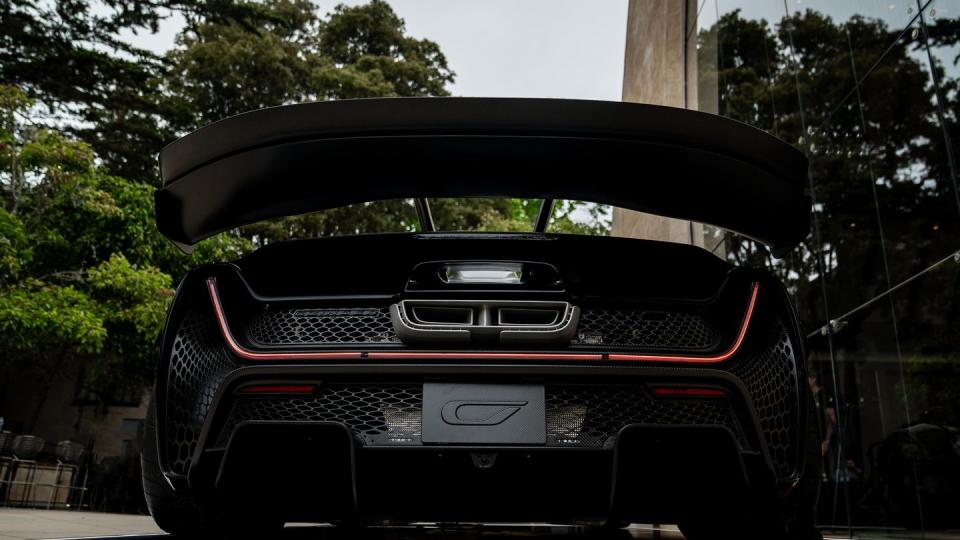How a SR-71 Blackbird Inspired Hypercar Could Change Manufacturing

There is no shortage of crazy hypercars coming out of Monterey Car Week, but the Czinger 21C Blackbird edition pays homage to a special speed machine.
With design inspiration from the Lockheed SR-71 Blackbird, Czinger has upped the power, but the real story of the father-son duo lies in how these models are marketed.
Additive manufacturing remains a controversial, but Divergent is set to open 25 factories in the next 10 years, all in the US or mainland Europe.
Kevin and Lukas Czinger are not your suit-and-tie kind of car company founders. A wide-brimmed hat, a corduroy jacket, and some tall yet chunky boots make up the stylistic choices between the father-son-duo at the Quail. And, just like their cars, this avant grade impression sets them apart from the Bugattis and McLarens of the world.
Similarly, the pair's family-named limited-run hypercar company, Czinger, is a bit more than a new logo for millionaire and billionaire shoppers. It's well-documented that the family's other company, Divergent 3D, is revolutionizing auto manufacturing with its additive, 3D printing, AI-designed processes.

Revealed at the Quail during Monterey Car Week, the 2024 Czinger 21C Blackbird edition is a poster child for Czinger and Divergent 3D's capabilities. Inspired by the Cold War era Lockheed SR-71 Blackbird reconnaissance aircraft, the roadgoing hypercar features jet black paint with integrated exposed carbon surfaces and a custom exhaust reminiscent of the speed-of-sound-tripling afterburners.
Visually, the 21c Blackbird edition is much more aggressive than its predecessors, with a towering wing and thick carbon-fiber front splitter. Even the carbon wheels are inspired by the dual-Pratt & Whitney powered Dorito jet, as the wheel design resembles a top shot of the aircraft in motion.
Power has been bumped up to 1350 hp from the proprietary 2.8-liter V8, while the suspension and brakes remain largely the same as previous versions of the 21C. That is to say intense, with every piece 3D-printed to order with maximum efficiency and minimal size, all calculated to carry a guaranteed load.
"There's no CAD engineer surfacing, which saves a bunch of time. It runs hundreds of thousands of simulations of adding material and subtracting against whatever the load cases requirements are," explained Lukas Czinger, chief operating officer at Divergent and co-founder of Czinger, in an interview with Autoweek.
As a result, essential but traditionally heavy parts of the car (steering column, gearbox, etc) are around 40% lighter than if Czinger was casting them. Lighter is always better when you're designing a hypercar, but Czinger said this unique production process isn't without its own challenges.

To 3D-print such lightweight parts, Czinger said the printer size is relatively small, and the production process can join many small pieces. By contrast, most traditional automakers try to have as few steps as possible between the aluminum shell and the road-ready car. However, printing small pieces makes the process more precise.
You'll want everything to be precisely built when driving 253 mph in your 21c, but Czinger said the future of both companies isn't just about top-speed runs.
"The two companies exist for very clear purposes rather than passion. What Czinger really does is incubates this new cutting-edge technology and puts it in an actual product that's fully street-legal and homologated," Czinger said.

In essence, Czinger acts as the showcase for Divergent 3D's ingenuity, and there are already interested parties. Aston Martin is the only brand publicly relying on this additive production model, though Czinger said a half dozen other brands are in talks with the Torrance, California-based company.
Similarly, the homage-paying Blackbird edition may be a relic of father-son model-plane-building bonding time, but Lockheed itself is also keenly following the company. Talk about a full-circle moment.
But what does all this top-level engineering have to do with someone trying to buy their next commuter car? Well, it means cars could come faster in the future, literally.

Without hours of human labor needed to ground-up design and structurally test mechanical pieces, production timelines will, in theory, be shorter. Done right, additive manufacturing could lead to a more consistent quality factor as well, though initial growing-pain R&D costs could be higher.
But first major manufacturers will have to buy into the technology, or at least believe in it on a mass scale. And prior reporting from Autoweek's own Mark Vaughn shows this prospect is a mixed bag. General Motors sees some value in it while Toyota has said it uses additive manufacturing sparingly. Both BMW and VW use it for certain small parts, too.
At this point, Czinger can handle an annual production rate of a few thousand chassis, so the technology at Divergent isn't quite ready for the volume of a manufacturer like Ford. But the father and son remain committed to changing the environmental footprint of car manufacturing.
To do this, Czinger confirmed that Divergent is set to open 25 factories in the next 10 years, all in the US or mainland Europe. One in the US and one in Europe are actually scheduled to open within two years. It's not clear which customers will use these plants with Divergent technology, but the future of additive manufacturing seems bright.
How do you think additive manufacturing and 3D printing will play out from an auto industry and labor relations perspective? Please share your thoughts below.

 Yahoo Autos
Yahoo Autos 